Email Sales Funnel: 4 Strategies That Actually Convert

Every business owner wants their marketing to work 24/7. A well-built email sales funnel can make this happen.
Think about your last marketing campaign. Your list grew bigger, but sales stayed flat. Your conversion rate was stuck at 2%.
Don't worry - you're not alone. HubSpot found that 45% of small businesses don't have an email funnel at all.
The numbers tell a clear story. Campaign Monitor shows that companies lose over 22% of their subscribers each year when emails don't connect with readers.
But there's good news.
Data & Marketing Association research proves that email sorting leads to a 760% jump in revenue.
That's real money you could be earning.
This article will show you how to turn basic emails into sales machines. Here's what you'll learn:
Discover how a simple tweak stops subscribers from vanishing (and can save you thousands in lost revenue)
Learn the proven segmentation method that multiplies email revenue by 18x (even with a small list)
Master the "VACuum Formula" that transforms every marketing dollar into $44 in pure profit
Uncover the delivery secret that puts you ahead of 35% of marketers (and straight into more inboxes)
Get the tested subject line framework that makes over half your list eager to open every email
Want to see your email marketing bring in more sales while you sleep? Let's get started...
If you want to get your marketing work done for your business (or for your clients’), then you HAVE to learn more how you can delegate unlimited marketing projects & tasks without the headaches of hiring. Download this free guide: 33 Examples of Marketing Projects You Can Delegate to Growbo
Common Mistakes That Cost You Leads
According to recent data from Campaign Monitor, businesses lose up to 22.5% of their email subscribers annually through poor engagement practices.
Two critical mistakes continue to plague businesses in their email marketing efforts. The first major pitfall is operating without an email funnel at all, which according to a HubSpot study, affects nearly 45% of small businesses in 2024.
The second crucial mistake is treating all subscribers identically by funneling them into a single email list and sending generic newsletters.Research from Mailchimp shows that segmented email campaigns achieve 14.31% higher open rates and 100.95% higher click rates compared to non-segmented campaigns.

Here's why generic email marketing undermines your potential for conversion:
- New subscribers receive no proper introduction to your business solutions
- Your content lacks personalization and relevance to individual needs
- You miss out on 18x more revenue potential that comes from segmented campaigns
Key Takeaways:
- Implement an email funnel immediately to stop losing potential leads
- Start segmenting your email list based on subscriber behavior and preferences
- Focus on personalized content delivery for higher engagement rates
Email Sales Funnel Strategy #1 - Precise Segmentation for Higher Sales
Effective segmentation begins with your welcome sequence, which serves as the foundation of your email sales funnel. Instead of immediately pushing sales messages, start by understanding your subscriber's needs through strategic segmentation.
Welcome Email Strategy
Your welcome email should include a simple but powerful question about their primary challenge. According to Mailmodo, including interactive elements in welcome emails can increase engagement rates by up to 300%.
Subscriber Bucketing Example
For digital marketing businesses, your welcome email might ask: "What's your biggest marketing challenge right now?" with these options:
- Generating quality leads
- Converting traffic into sales
- Creating engaging content
- Optimizing marketing ROI
Response-based Follow-up
Based on subscriber responses, create targeted follow-up sequences that address specific pain points. Research shows that segmented email campaigns achieve 14.31% higher open rates and 100.95% higher click rates compared to non-segmented campaigns.
To find out other ways to segment your audience, we identified 17 ways to segment in this article.
Key Takeaways:
- Start with a strategic welcome email that segments subscribers based on their needs
- Create specific content paths for each subscriber segment
- Monitor and optimize response rates for each segment
Email Sales Funnel Strategy #2 - The VACuum Formula Explained
The VACuum formula represents three essential elements that power successful email sales funnels. Let's break down each component and see how they work together to create a compelling email sequence.
Value Delivery
Start by delivering educational content, tools, or resources that directly address your subscriber's stated challenges. According to the Email Marketing Benchmark report, including valuable content in emails increases engagement rates.
This is an example value-laden email:
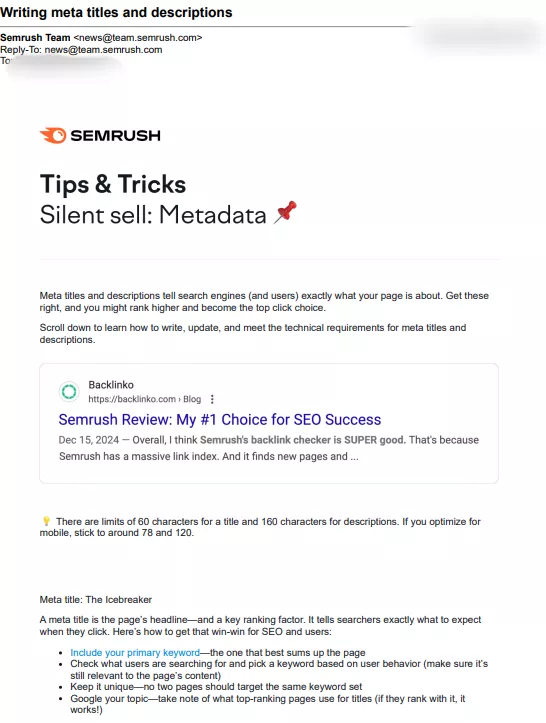
Authority Building
Share your company's journey, showcase success stories, and present case studies that position your business as the go-to expert. This builds trust and credibility with your audience.
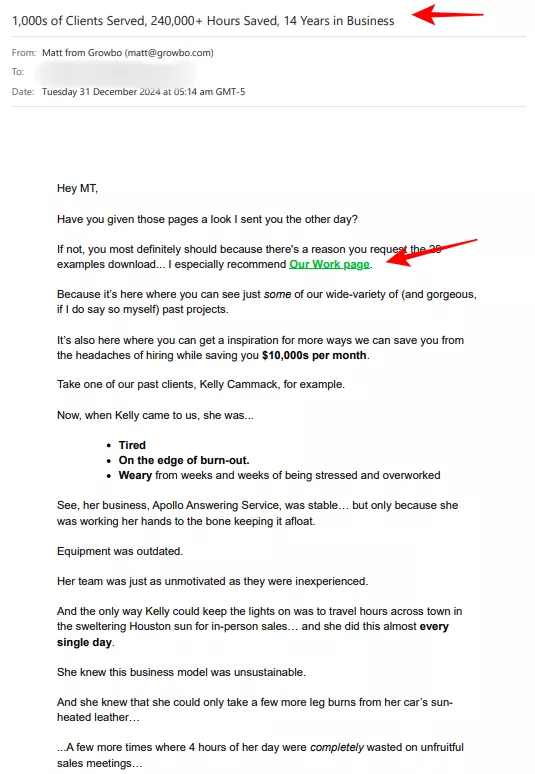
Call-to-Action Implementation
Present clear, compelling offers that naturally flow from the value and authority you've established. Research shows that personalized CTAs perform 202% better than basic CTAs according to HubSpot.
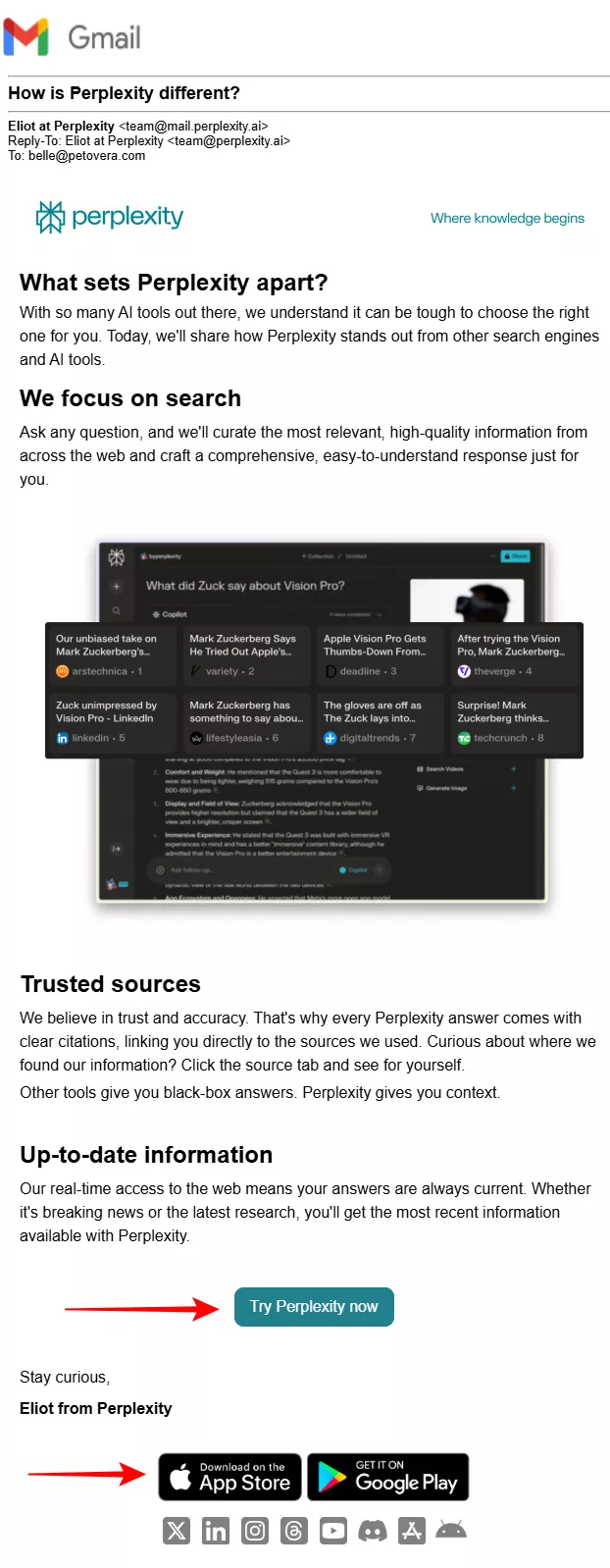
Implementation Checklist
- Value Phase:
- Create educational content aligned with segment needs
- Develop downloadable resources
- Share industry insights and tips
- Authority Phase:
- Share relevant case studies
- Include customer testimonials
- Demonstrate expertise through data
- CTA Phase:
- Present clear, compelling offers
- Include urgency elements
- Add social proof
Key Takeaways:
- Follow the VACuum formula sequence for maximum impact
- Customize each phase based on subscriber segments
- Monitor and optimize each component's performance
Email Sales Funnel Strategy #3 - The Open Loop Strategy
According to recent email marketing studies, implementing open loop techniques in email sequences increases reader engagement by up to 45%.
The open loop strategy leverages the Zeigarnik Effect - our natural desire to seek closure when presented with an unfinished story. This psychological principle is particularly powerful in email marketing when properly executed.
Understanding the Zeigarnik Effect
Just like modern streaming services keep viewers hooked with cliffhangers, your email sales funnel can create the same compelling effect.
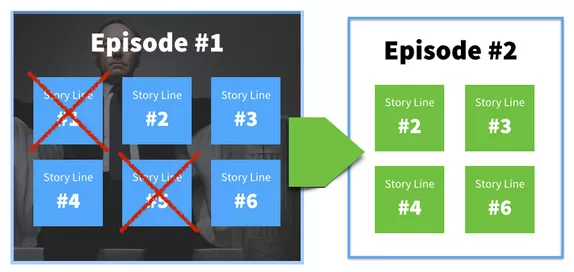
Creating Engagement Through Storytelling
Here's how to implement open loops in your email sales funnel:
- Start each email with an intriguing hook
- Create multiple story arcs across your sequence
- Leave strategic questions unanswered
- Promise valuable revelations in the next email
Implementation Examples
Here’s a great example to illustrate the concept. It’s from an old radio ad written by Roy H. Williams:
Antwerp, Belgium, is no longer the diamond capital of the world.
Thirty-four hours on an airplane. One way. Thirty. Four. Hours. That’s how long it took me to get to where eighty percent of the worlds diamonds are now being cut. After 34 hours I looked bad. I smelled bad. I wanted to go to sleep. But then I saw the diamonds.
Unbelievable. They told me I was the first retailer from North America ever to be in that office. Only the biggest wholesalers are allowed through those doors. Fortunately, I had one of ‘em with me, a lifelong friend who was doing me a favor.
Now pay attention, because what I’m about to say is really important: As of this moment, Justice Jewelers has the lowest diamond prices in America, and I’m including all the online diamond sellers in that statement.
Now you and I both know that talk is cheap. So put it to the test. Go online. Find your best deal. Not only will Justice Jewelers give you a better diamond, we’ll give you a better price, as well.
I’m Woody Justice, and I’m working really, really hard to be your jeweler. Thirty-four hours of hard travel, one way. I think you’ll be glad I did it.
And an example from Andre Chaperon in utilizing open loop in his emails.
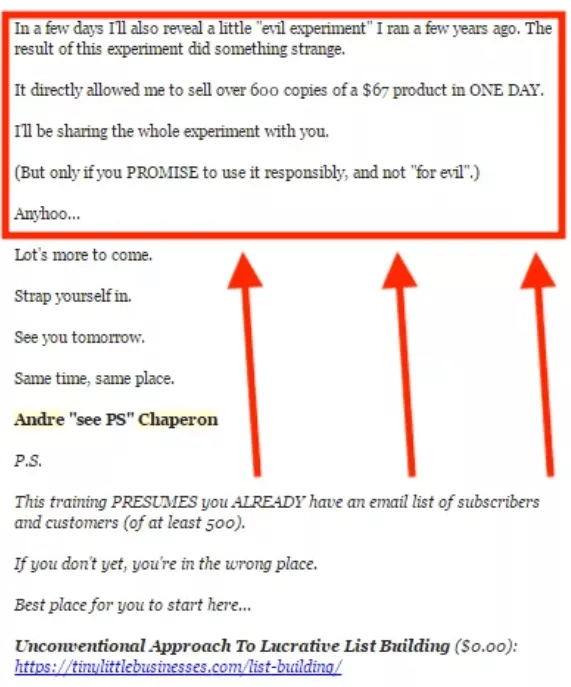
Key Takeaways:
- Use the Zeigarnik Effect to maintain subscriber engagement
- Create multiple story arcs throughout your email sequence
- Always deliver on promised revelations to maintain trust
Email Sales Funnel Strategy #4 - Implementation Framework
Creating an effective email sequence requires careful planning and systematic execution. Let's break down the key components of a successful implementation.
Welcome Sequence Setup
- Day 1: Send the segmentation survey
- Day 2-3: Deliver segment-specific value content
- Day 4: Share authority-building case studies
- Day 5: Present your first relevant offer
Segment-Specific Content Creation
According to recent statistics, personalized emails have a 14% higher CTR compared to non-personalized emails. Also, email campaigns that are segmented see 14.31% higher open rates and 100.95% higher click-through rates
Here's how to structure your content:
- Develop unique value propositions for each segment
- Create targeted case studies and success stories
- Craft segment-specific offers and calls-to-action
Performance Metrics to Track
Monitor these key metrics to optimize your email sales funnel:
- Open rates by segment
- Click-through rates on specific content types
- Conversion rates for different offers
- Engagement patterns across the sequence
Key Takeaways:
- Follow a structured implementation timeline
- Create segment-specific content paths
- Monitor and optimize based on key metrics
Implementation Tips
Research shows that businesses using automation in their email funnels achieve 320% more revenue than those using non-automated campaigns (Mailmodo, 2024).
Here are the key steps to get started:
- Set up your email marketing platform
- Create your segmentation survey
- Develop content for each segment
- Implement tracking and analytics
- Monitor and optimize performance
Key Takeaways:
- Start with proper segmentation
- Follow the VACuum formula
- Use open loops to maintain engagement
- Monitor metrics and optimize regularly
Troubleshooting Your Email Sales Funnel
Even the best-designed email funnels can face challenges. In 2024, the average email deliverability rate across the 15 ESPs tested is 83.1% according to Email Tool Tester.
On the average, 10.5% ended up on the recipient’s spam folder and 6.4% of the emails go missing or “undelivered.” That is 1 out of 6 marketing emails not reaching the inbox.
So, let's address common challenges and their solutions to ensure your email sales funnel performs optimally.
Common Issues and Solutions
- Low Open Rates:
- Improve subject lines
- Optimize send times
- Clean your email list regularly
- Poor Click-Through Rates:
- Enhance content relevance
- Test different CTA placements
- Use more engaging visuals
- High Unsubscribe Rates:
- Review segmentation strategy
- Adjust email frequency
- Enhance content quality
Measuring Success
According to Mailmodo's latest research, successful email funnels should maintain open rates above 20% and click-through rates above 2.5%
Here are the key metrics to track:
- Conversion rates by segment
- Revenue per email
- List growth rate
- Engagement trends
Key Takeaways:
- Monitor key metrics regularly
- Address issues promptly
- Test and optimize continuously
If you want to get your marketing work done for your business (or for your clients’), then you HAVE to learn more how you can delegate unlimited marketing projects & tasks without the headaches of hiring. Download this free guide: 33 Examples of Marketing Projects You Can Delegate to Growbo
CONCLUSION
Creating an effective email sales funnel is crucial for your marketing success. As we've explored, the key to maximizing your email marketing ROI lies in strategic segmentation, personalized content delivery, and systematic implementation of proven frameworks like the VACuum Formula.
The landscape of email marketing automation continues to evolve, but the fundamental principles remain constant: deliver value, build authority, and convert through strategic engagement.
Here are the essential takeaways from this comprehensive guide:
- Strategic segmentation can increase email revenue by up to 760%
- The VACuum Formula (Value-Authority-Conversion) creates a systematic approach to email marketing success
- Open loop techniques boost engagement rates
- Personalized content delivery can achieve 200-300% higher click-through rates
- Regular monitoring and optimization are crucial for maintaining funnel performance
Ready to implement these strategies but feeling overwhelmed by the technical details and time investment required? Instead of spending countless hours building and managing your email funnels, let our team of marketing experts handle it all for you. Try Growbo for just $7 for 7 days and see how we can improve your email marketing strategy while you focus on growing your business.
We'd love to hear about your experiences with email marketing. What challenges have you faced in building your email sales funnel? Share your thoughts in the comments below.
Keep Growin,’ Stay Focused,

Image Credits:
https://mailchimp.com/resources/effects-of-list-segmentation-on-email-marketing-stats/













